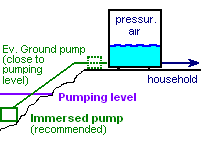Pumping pressurization system
This system assumes pumping from a generic water source (other storage, lake or river), into a tank which ensures a water static pressure allowing for distribution to customers. This is an alternative of "high" tanks like water towers. The pressurization is obtained by the compression of the air in the closed impervious tank volume when water level increases.
The pump's problematics is the same as for lake/river, except that it's maximum head capabilities are usually higher:
- The pump may be placed near the source (no more than 4-5 m above the water surface, less at high altitudes, for avoiding cavitation problems).
- The pump is not necessarily of "Submersible" type, therefore much cheaper. On the other hand, being in open space, it's maintenance is more easy.
Remember that the Pressure or Head is related to the difference between the input and output levels, to which the pressurization should be added. The pump has to provide a total head resulting of the following contributions.
In PVsyst we take reference to the ground level, we have (cf fig):
$ HT = HG + HS + HF + HP $
where:
HG = head due to the height of the outlet pipe above the ground (assuming that outlet pressure is negligible).
HS = static head due to the depth of the water level, with respect to the ground.
HF = friction losses in the piping circuit, which depend on the flowrate.
HP = Pressurization contribution required for distribution.
For this system, in the "Pumping Hydraulic definitions" dialog, you will be asked to specify:
- The source level depth, with respect to the ground. This may be also be given in seasonal or monthly values, in the "Water Needs" next dialog.
- The maximum pressure in the tank (stop pumping),
- The minimum pressure in the tank (stop feeding the users),
- The pressurization (air) volume at minimum pressure.
You will also define the Storage Tank and Hydraulic circuit parameters.
A little graphical tool shows the total head and its contributions, as a function of the pump flowrate.
